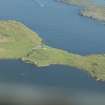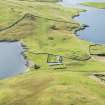Lunna Ness, Lunna Church And Churchyard, War Memorial
Burial Ground (Post Medieval), Church (18th Century), Churchyard (Post Medieval), Grave Slab(S) (17th Century), War Memorial (20th Century)
Site Name Lunna Ness, Lunna Church And Churchyard, War Memorial
Classification Burial Ground (Post Medieval), Church (18th Century), Churchyard (Post Medieval), Grave Slab(S) (17th Century), War Memorial (20th Century)
Alternative Name(s) Lunnasting, St Margaret's Kirk; War Memorial; Norwegian Seamen Memorial; N Nesse Memorial Cross; Seaman's Memorial
Canmore ID 1199
Site Number HU46NE 9
NGR HU 48590 69089
Datum OSGB36 - NGR
Permalink http://canmore.org.uk/site/1199
- Council Shetland Islands
- Parish Nesting
- Former Region Shetland Islands Area
- Former District Shetland
- Former County Shetland
HU46NE 9 48590 69089
For adjacent chapel, see HU46NE 4.
HU 4863 6910 In December 1999 an oval grassy mound was partially excavated in advance of a graveyard extension to be developed at Lunna Kirk. Although similar in appearance to several mounds to the W of the kirk, which are believed to cover Viking burials, the excavated mound consisted of dumped clay, stones and lime plaster.
Sponsor: Shetland Amenity Trust.
B Simpson 2000
Field Visit (July 1934)
Lunna Church. This church falls outside the scope of the Inventory. Built into the porch, however, just within the door, are two inscribed slabs which have evidently come from the pre-existing family mausoleum of Lunna (1).
The first, which measures 4 ft. by 2 ft., bears a coat of arms in its upper part and the inscription below. The shield is charged: A chevron (?) couped between three hunting horns; it bears helm and mantling, and for crest a star, and is flanked by the incised initials R H. The inscription reads: HERE REST THE BONES & DUST OF / ROBERT HUNTER OF / LUNA & OF MARGA/RET LESLIE HIS SPOWS. These words are in raised letters and the original inscription ends there. A later hand has cut, in incised letters, HE WAS BORN IN 15[ ] & DIED IN 16[ ]. Later still the blanks have been filled with the painted figures 99 and 98. Beneath, incised in sloping letters, is the following: HIS ELDEST SON, WILLIAM HUNTER OF LUNA / LUNNA OR LYNNA/ SURVIVED HIM [ ] YEARS / & WAS ALSO BURIED HERE. The blank has been filled, apparently by the same hand as the blanks above, by inserting 18.
These additions are obviously quite wrong. Robert Hunter of Lunna married Margaret Leslie in 1678 and had by her eleven children (2), which would have been an impossible feat for a man of 79. Moreover the date of his death is given (3) as somewhere between 20th July 1693 and 3rd May 1695. Further, his eldest son, William, who succeeded him, died in 1702, less than ten years after his father. He was born in 1679.
The second inscription reads: ANNO MDCCXIX / PULVIS ET UMBRA SUMUS. It seems possible that this may be the lower portion of the tombstone of Thomas Hunter, second son of Robert, who was born in 1680 and died in 1718.
Seeing that William was unmarried and that Thomas's widow re-married in 1720, the four persons mentioned above are the only ones who are likely to have been buried in the "tomb" or family mausoleum except, perhaps, Thomas's eldest son, William, who died young. Robert Hunter of Lunna, who was the next laird, was born in 1710 and was proprietor when the church was built. He lived until 1777.
RCAHMS 1946, visited July 1934.
OS 6" map, Shetland, 2nd ed. (1903)
(1) In June 1753 the Presbytery agreed with Robert Hunter of Lunna that he should build a parish kirk "at the tomb of Lunna," and that he should oblige himself and his heirs to keep the same in repair. It was to be a chapel of ease, and was evidently the first church on the site. It was renovated in 1830, and again in 1933.
(2) Zetland Family Histories, pp. 161 ft.
(3) Loc. cit.
Publication Account (1997)
Still in use as the parish church, this building has a particularly light and attractive interior. It was built in 1753, possibly on medieval foundations, by Robert Hunter of Lunna as a simple rectangular church with a porch, and it was renovated both in 1830 and 1933. An oddity is the small annexe on the south side with a small opening into the church, which has been interpreted both as a 'squint' for the priest to keep an eye on the altar while resting and as a 'leper hole', a small opening in the wall of the church through which the afflicted could listen to the service and receive communion without distressing the rest of the congregation. On balance the former explanation is thought to be the most likely. Built into the wall of the porch are two 17th century graveslabs, which came from the Hunter family mausoleum that existed before the church was built. Inside the church, a fine 18th-century memorial is set into the wall beside the pulpit.
Although no previous church was in use at Lunna in 1753, the existing church was not the first to be built here. Adjacent to the churchyard, and approached through an unexpectedly grand gateway, is a large irregular mound (probably of prehistoric origin) on which a chapel with an enclosure had been built perhaps in the 12th century. Its foundations are clearly visible as a rectangular building with an entrance to the southwest, but it is not known when the church went out of use.
The imposing gateway is a landscape feature belonging to Lunna House, which overlooks the site, built in the la te 17th century as the seat of the Hunter family and expanded in the 18th and 20th centuries (now a hotel). Incorporated into the external front of the house is an armorial panel which has been moved from its original position and which commemorates the marriage in 1707 of Thomas Hunter and Grisella Bruce. The house was for a time the HQ of the Norwegian resistancemovement in the Second World War, and the base for boats ferrying armaments and men across the North Sea to occupied Norway (see chapter 1). On the shore of West Lunna Voe is an excellent example of a circular beehive-shaped limekiln (HU 484693), while farther round the voe to the north is a superb prehistoric burnt mount of classic crescent form (HU 484694, see chapter 9).
Information from ‘Exploring Scotland’s Heritage: Shetland’, (1997).










































































































